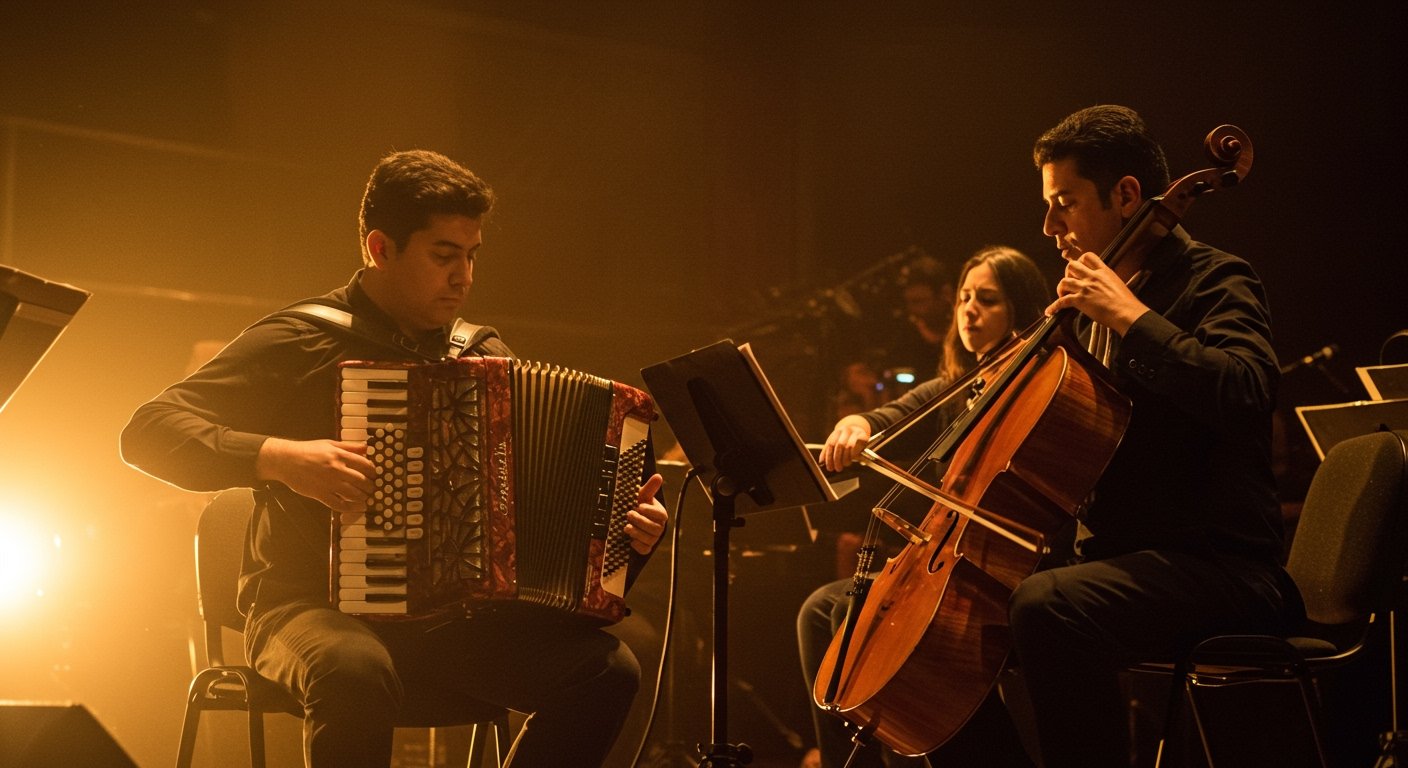WICHITA, KS – A unique cultural convergence is set to grace the stage in Wichita, Kansas, as the distinct sounds of Chamamé, a vibrant musical genre rooted in the border regions of Argentina and Brazil, are set to blend seamlessly with the refined tones of classical music. This anticipated performance, sponsored by the Wichita Symphony Orchestra (WSO), features the acclaimed Alejandro Brittes Quartet in a compelling collaboration with a dedicated WSO string quartet.
This concert promises to be more than just a musical event; it is an exploration of heritage, innovation, and the universal language of music that transcends geographical boundaries. By bringing together the earthy, rhythmic complexity of Chamamé and the structured harmony of classical strings, the performance aims to offer audiences a fresh perspective on both genres.
Understanding Chamamé: A Rhythmic Tapestry
Chamamé is far more than just music in its native lands; it is a cultural cornerstone, deeply intertwined with the identity of the Argentine province of Corrientes and parts of southern Brazil, Paraguay, and Uruguay. Characterized by its distinctive syncopated rhythms, often driven by the accordion (or acordeón) and the guitarra chamamecera (a specialized six-string guitar), Chamamé evokes the spirit of the Pampa and the rich riverine landscapes of the region.
Its roots lie in a fascinating blend of indigenous Guaraní influences, Spanish and Jesuit missionary contributions, and later European folk music traditions brought by immigrants. The genre is known for its expressive melodies, often melancholic yet simultaneously celebratory, capable of moving listeners to dance or introspection. It’s a music that tells stories of the land, love, and life along the great rivers like the Paraná.
The genre’s evolution has seen it incorporate various instruments and styles, but its core identity remains tied to its folk origins. The inclusion of classical elements, as explored by artists like Alejandro Brittes, represents a contemporary evolution, bridging the gap between traditional folk expression and formal musical structures.
Alejandro Brittes: A Life Steeped in Sound
Central to this cross-genre collaboration is Alejandro Brittes, a recognized master and innovator within the Chamamé world. His journey with the music began at a young age, rooted deeply in his personal history and upbringing. In a detailed interview published in the Miami Herald on July 9, 2025, Mr. Brittes shared intimate insights into his connection with this powerful music.
Born and raised in Argentina, Brittes was immersed in the sounds of Chamamé from his earliest memories. He described an environment where the music was not just heard but lived, present at family gatherings, local festivals, and woven into the fabric of daily life. This constant exposure forged a profound and lasting bond with the genre, shaping his perspective and artistic path.
Brittes recounted his early aspirations to become a musician, driven by a passion ignited by the vibrant rhythms and expressive melodies of Chamamé. He dedicated himself to mastering the accordion, one of the genre’s signature instruments, and delved deep into its traditions, history, and variations. His commitment wasn’t just about technical proficiency; it was about preserving and promoting the soul of Chamamé.
Over the years, Brittes has become a leading figure, not only performing traditional Chamamé but also exploring its potential for dialogue with other musical forms. His quartet is known for its dynamic performances and its role in bringing Chamamé to international stages, introducing new audiences to its unique charm and complexity. His work is seen as vital in ensuring the genre’s continued relevance and evolution in the 21st century.
The Collaboration: Bridging Worlds
The concert featuring the Alejandro Brittes Quartet alongside a WSO string quartet represents a deliberate and exciting act of musical fusion. The concept aims to explore how the improvisational spirit and distinctive rhythmic patterns of Chamamé can interact with the formal arrangements and textures provided by classical string instruments – violins, viola, and cello.
The collaboration involves a process of musical arrangement and rehearsal that seeks to honor the integrity of both traditions while creating something entirely new. The WSO string quartet, composed of accomplished classical musicians, must navigate the nuanced syncopations and unique phrasing of Chamamé, learning to complement the accordion and guitar rather than simply accompanying them.
Conversely, the Alejandro Brittes Quartet adapts its performance to integrate with the string quartet, finding spaces for their instruments to weave in and out of the classical arrangements. This requires a deep understanding of both musical languages and a willingness to experiment and find common ground. The result is anticipated to be a rich, multi-layered soundscape that highlights the surprising affinities between Argentinian/Brazilian folk rhythms and classical music.
This partnership exemplifies the global nature of music today, where artists are increasingly looking beyond traditional boundaries to create innovative experiences. It’s a testament to the versatility of Chamamé and the adaptability of classical musicians.
A Cultural Exchange in Wichita
The decision by the Wichita Symphony Orchestra to sponsor this concert underscores a commitment to presenting diverse musical experiences to its audience. Bringing the Alejandro Brittes Quartet to Wichita, Kansas, provides a rare opportunity for the community to engage directly with a significant, yet perhaps less familiar, Latin American cultural tradition.
Such cross-cultural performances play a crucial role in fostering understanding and appreciation between different communities. They expose audiences to new sounds, rhythms, and stories, broadening perspectives and celebrating the world’s rich musical heritage. For attendees in Wichita, this concert is an invitation to journey musically to the heart of South America.
Moreover, the collaboration itself serves as a powerful symbol of artistic cooperation. It demonstrates how musicians from vastly different backgrounds can come together, learn from one another, and create something beautiful and meaningful through shared effort and mutual respect. This kind of exchange enriches not only the artists involved but also the cultural landscape of the city hosting the event.
The concert is expected to draw enthusiasts of classical music, world music aficionados, and those simply curious to experience a unique performance. It highlights Wichita’s role as a city open to international artistic dialogue and committed to offering varied programming that reflects the globalized world.
Conclusion: A Harmonious Future
The concert featuring the Alejandro Brittes Quartet and the WSO string quartet stands as a testament to the enduring power of music to connect people and cultures. By fusing the evocative rhythms of Chamamé with the elegant structures of classical strings, the performance offers a compelling vision of musical evolution and collaboration.
Based on the insights shared by Alejandro Brittes in interviews, including that with the Miami Herald, his personal journey is deeply intertwined with the narrative of Chamamé itself – a tradition that is both historically rooted and vibrantly alive, capable of constant reinvention. This concert in Wichita is not just a performance; it is a celebration of this dynamic genre and a successful example of how different musical worlds can converge to create something truly harmonious and memorable for audiences.
The event promises to be a highlight of the cultural calendar, leaving attendees with a deeper appreciation for the rich traditions of Latin American folk music and the boundless possibilities of cross-genre collaboration.





